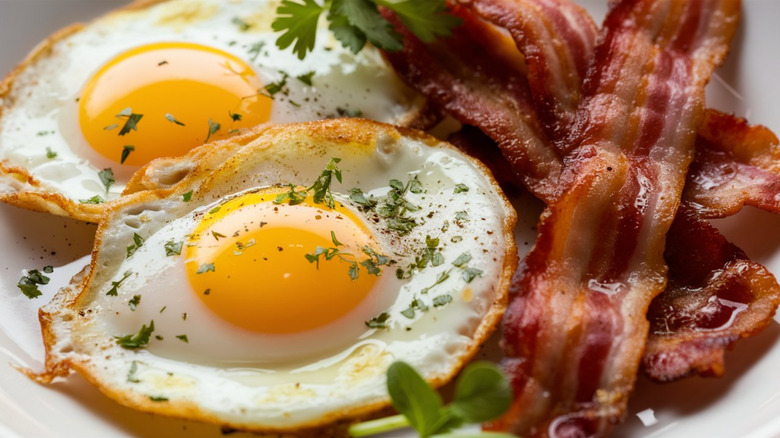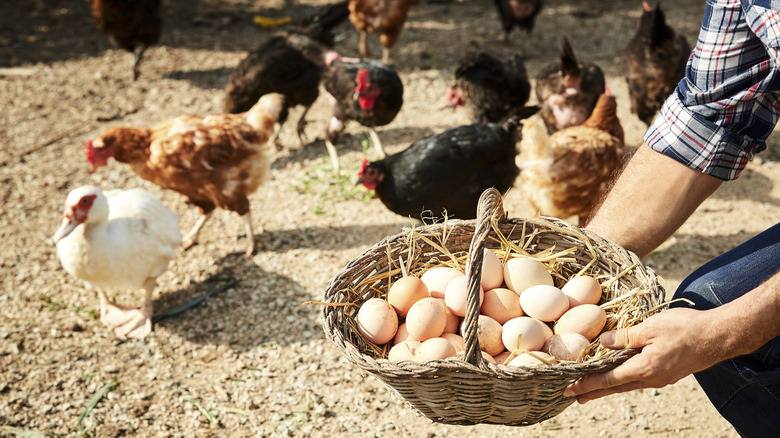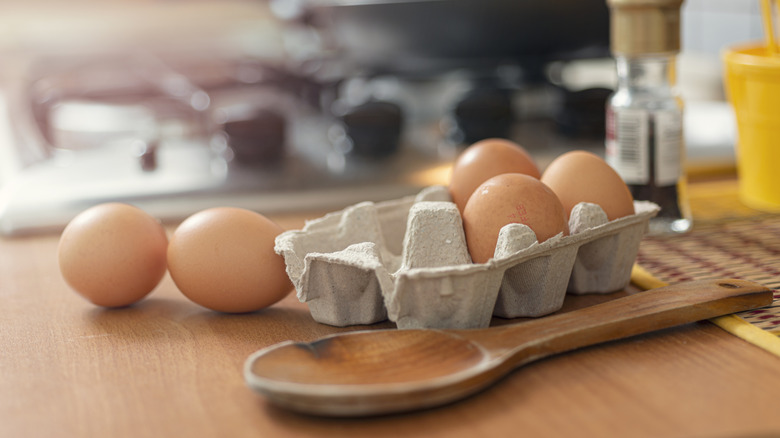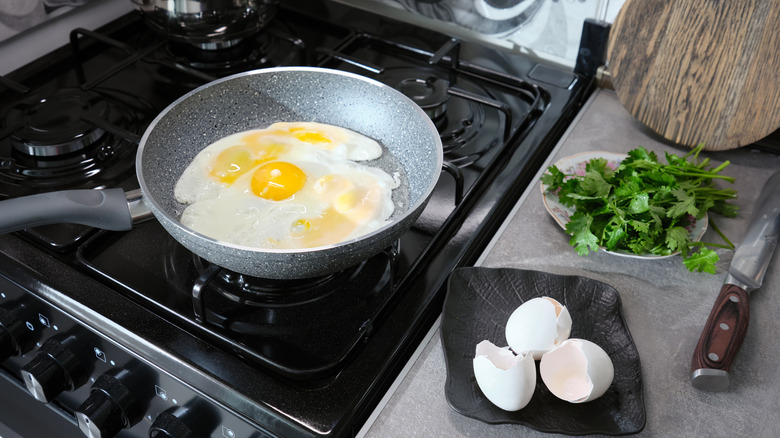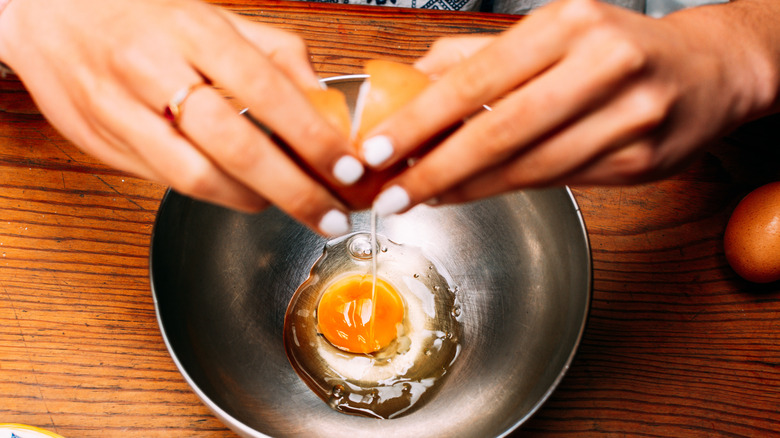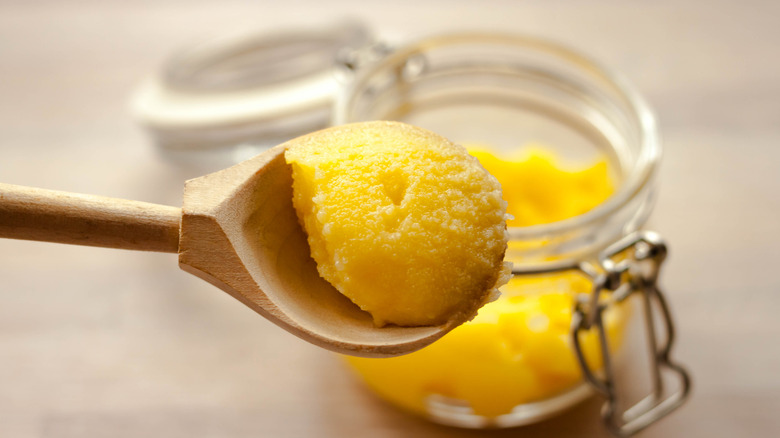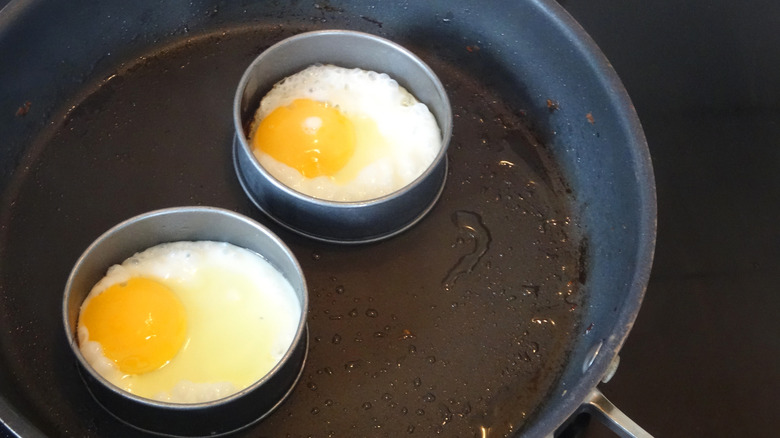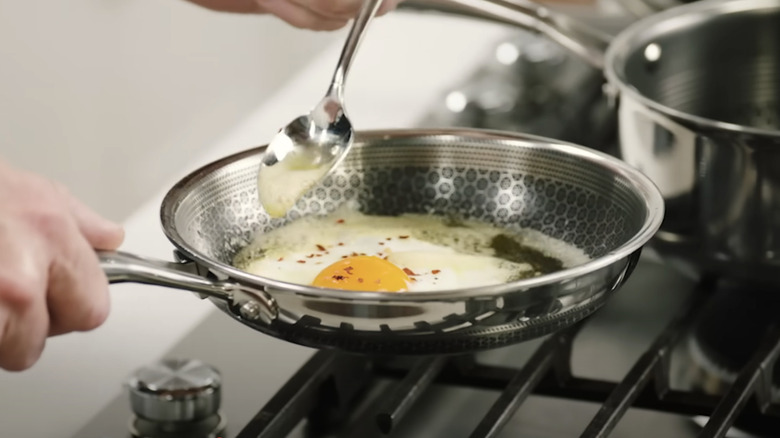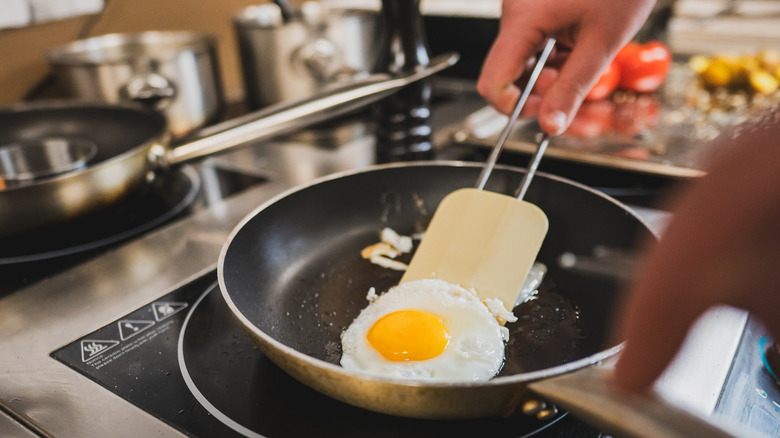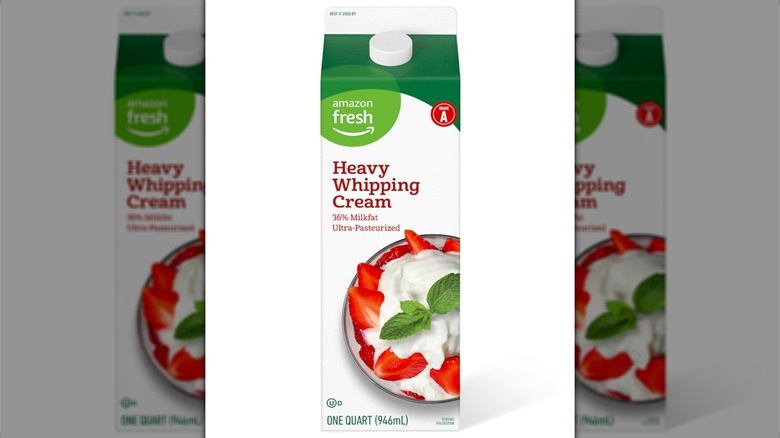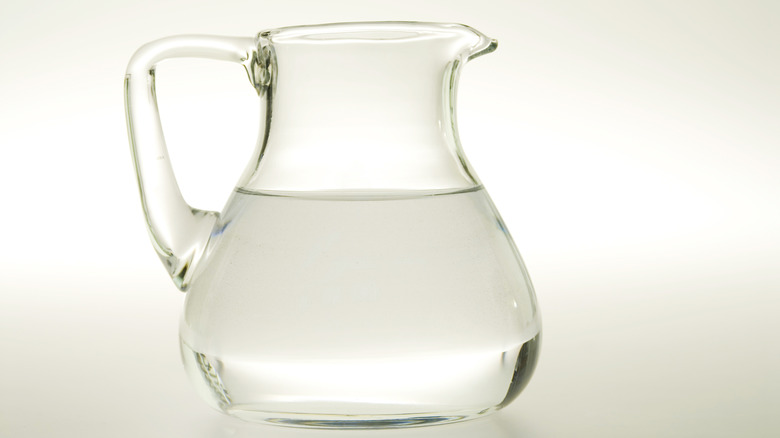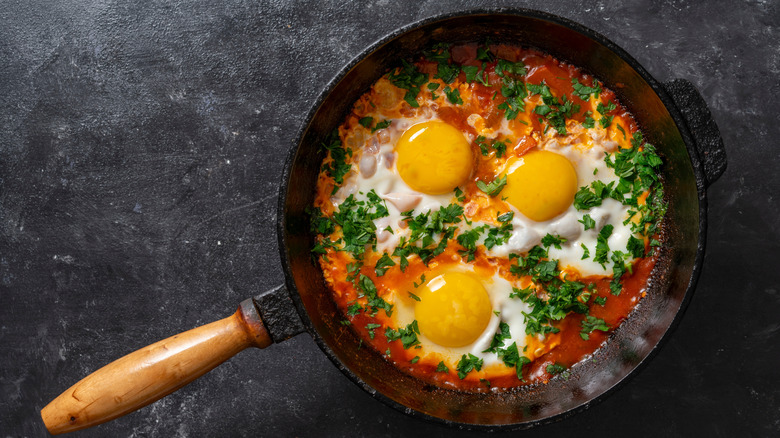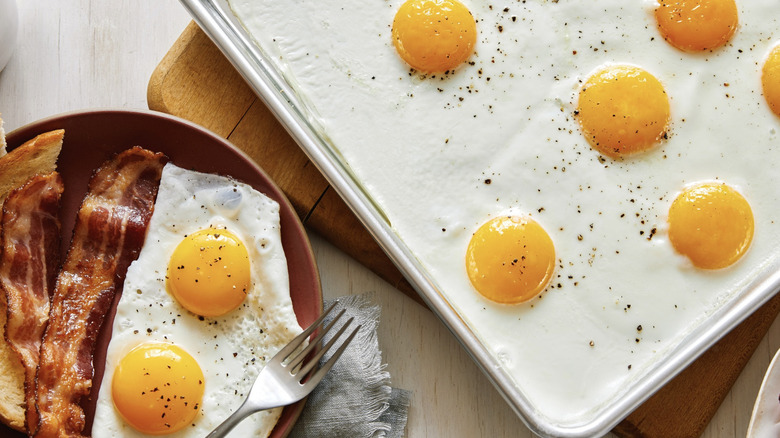Fried Egg Hacks You'll Use Again And Again
We may receive a commission on purchases made from links.
Often served alongside crispy bacon, buttered toast, and hash browns, fried eggs are a popular breakfast staple. They are also frequently used as an ingredient in burgers, a topping for noodles or fried rice, or even a finishing touch on pizza. Despite being a classic dish, fried eggs can be surprisingly tricky to perfect.
Fried eggs take more effort than their scrambled counterparts. While scrambled eggs require little finesse — they are scrambled after all — frying eggs involves attention to detail and careful handling. This is particularly true because different people prefer their fried eggs prepared in very specific ways, from sunny-side up with runny yolks to eggs over easy with slightly set yolks to fried eggs with thoroughly cooked centers.
Making the perfect fried eggs takes the right equipment, the correct technique, and precise timing. Luckily, with a little know-how and practice, you will be cracking diner-quality fried eggs in no time. Ready to impress your family and friends? Check out our tips to elevate your breakfast game right now!
Use fresh, high grade eggs
While older hard-boiled eggs may be easier to peel, for fried eggs, freshness is key. And when it comes to eggs, farm-fresh is as good as it gets. For many, the differences between store-bought and farm eggs are immediately visible. The yolks of farm-fresh eggs are a vibrant yellow in color while the hallmark of store-bought eggs are medium yellow-hued yolks. Farm eggs also tend to be creamier than their commercially produced counterparts.
However, the advantages of farm-fresh eggs don't stop there — they are also better for you than supermarket eggs. Farm hens are usually fed better diets than factory hens. They are also normally allowed to roam outside in the sun. According to tests conducted by Mother Earth News, this makes farm eggs four to six times richer in vitamin D and substantially lower in cholesterol and saturated fat than supermarket eggs.
If you don't have access to farm-fresh eggs, opt for a higher grade of eggs at your local grocery store. Higher graded eggs — ideally AA — offer firmer yolks and better quality whites, making them perfect for fried eggs. While grade A and B eggs are suitable for cooking, they are likely to lack the quality of grade AA eggs. Regardless of the type of eggs you purchase, always store them in the refrigerator to ensure that they remain safe to eat.
Bring the eggs to room temperature before frying
Storing eggs in the refrigerator is a common practice in the U.S. Unlike in some other countries, in the United States the USDA requires all commercially sold eggs to be washed and sanitized to prevent contamination. Ironically, this cleaning process also removes their protective coating, leaving the egg susceptible to bacteria. To reduce the risk of contamination, eggs must be stored below 45 degrees Fahrenheit.
Picture-perfect fried eggs consist of smooth whites without any bubbles and unbroken yolks. In short, fried eggs should be cooked thoroughly enough that they are safe to consume but not cooked to the point that they feature overly-set yolks and rubbery whites — unless this is your preference.
While it may be tempting to crack the eggs straight out of the refrigerator, frying them right away can lead to uneven cooking — affecting both the texture and flavor of your fried eggs. Since eggs taken out of the fridge are cold, the outside of the egg is likely to cook much faster than the inside. This, in turn, is likely to result in overcooked whites and undercooked yolks since the whites set faster than the yolks.
Use the right pan
As with other culinary endeavors, the right cookware can go a long way to ensuring perfectly fried eggs. Non-stick pans are by far the most popular choice for frying eggs, and for a good reason. After all, the last thing you want is eggs that have fused to the bottom of the pan and are impossible to flip or remove. To prevent this, avoid using stainless-steel pans to prepare fried eggs since they are normally used to create a crusty exterior in dishes such as sautéed vegetables and seared meats.
There are two types of non-stick pans — Teflon or PTFE-coated pans and ceramic pans. Teflon-coated pans are non-stick and lightweight, making them perfect for cooking with very little oil. However, they require careful handling. For instance, using metal utensils to flip or remove the eggs can easily damage them by scratching the coating. Also, Teflon has been linked to a number of safety concerns, particularly if heated above 570 degrees Fahrenheit.
An alternative to Teflon pans, ceramic pans are also non-stick. In addition, they are not coated with any synthetic chemicals. On the downside, the non-stick coating of ceramic pans can wear out faster than Teflon, particularly if they are not used with care.
Crack the eggs into a bowl first
When watching television cooking shows, it's not uncommon to see chefs effortlessly cracking eggs with one hand directly into a sizzling pan. As easy as this may look on television, replicating this trick at home can be difficult. This is because the one-handed crack can easily lead to broken yolks and eggshells in your food.
Since a part of a perfectly-prepared fried egg lies in aesthetics, it's wise to crack the eggs into a bowl before gently transferring them to the pan. Not only will this practice keep your yolks and whites separate, it will also give you time to pick out any stray bits of eggshell before you start the frying process. If any eggshell pieces make it into the bowl, try using one of the halves of the shell as a scoop. The natural stickiness of the egg whites is likely to make the shell fragments cling together. If you want to remove the little shards by hand, it's best to wet your hand before picking them out since this will make your fingers stickier.
While we all have slightly different egg cracking techniques, it's best not to crack eggs on the rim of a bowl. If the egg happens to shatter, you may end up with small pieces of shell in your egg mix. Instead, try to crack eggs on a flat surface like the kitchen countertop. Once the egg has a visible crack, hold it over a bowl and gently break its membrane with your thumbs before slowly pulling the shell apart.
Use the right cooking fat
When making fried eggs, most people grease the pan with either butter or oil to prevent any sticking. Even if using a non-stick pan, adding a small amount of butter or oil can both simplify the cooking process and improve the flavor and texture of fried eggs. While any oil or butter will do in a pinch, health-conscious cooks often fry their eggs in olive oil. This is because olive oil has a high smoke point and is rich in antioxidants and healthy monounsaturated fats.
Aside from oil and butter, you can also make fried eggs with other fats for extra flavor. For instance, frying eggs in bacon grease can imbue them with a delicious, smoky taste. Similarly frying eggs in beef tallow or duck fat can give them a richer and more nuanced flavor. Ghee is another fat option that pairs a high smoke point with a desirable nutty quality. For a burst of flavor, you can also use olive oil infused with herbs, spices, or even fruit. Some other popular fat options for frying eggs include avocado oil, which is praised for its nutty flavor, and corn oil, which can give your fried eggs beautiful, crispy edges.
Use a ring mold or onion rings
While some people like their fried eggs free-flowing, others prefer to use molds to achieve the polished look of rounded fried eggs. And there is a lot to be said for uniformly-shaped fried eggs. The molds don't just keep the egg whites neatly contained, they also help to cook the eggs more evenly. In addition, if you are making fried egg sandwiches, a perfectly-rounded egg usually fits neatly on bread or a bun.
Typically made from metal or silicone, egg rings come in different diameters. They also sometimes feature fun shapes or handles for easy lifting. To use an egg ring, choose a flat frying pan. Be sure to grease both the skillet and the egg ring, particularly if it's a metal one. Once the pan is preheated to medium or high heat, gently pour the egg into the egg ring. After a few minutes — depending on your desired level of doneness — lift the egg ring and use a spatula to transfer the egg from the pan to a plate.
For a fun twist on uniformly-shaped fried eggs, replace the ring mold with an onion ring. To do this, cut a large onion into thick slices and use them as molds when frying your eggs. Once done, you can either discard the onion ring or eat it with the egg for extra sweetness and crunch.
Baste the eggs in hot oil to get crispy edges
While some of us prefer our fried eggs to have a uniform texture throughout the whites, others like the contrast of crispy — slightly browned and crunchy — edges. Those who fall into the latter category will be pleased to know that there is an easy way to achieve these crispy fried fringes. All it takes is a hot pan and a little oil.
Basting eggs in oil as they fry can be a game changer for fans of crunchy egg whites. To use this method, pour the egg gently into a greased pan. As it begins to cook, tilt the pan to let the oil pool on one side, then use a spoon to drizzle the hot oil over the whites. Because the edges of the egg are thinner, they will crisp up first, leaving the rest of the white nice and tender. Provided that you don't accidentally baste the yolk, it will stay golden and perfectly runny.
Oil isn't the only fat you can use for basting eggs. In a cooking demonstration for HexClad Cookware, Gordon Ramsay bastes his fried eggs in butter instead of oil, giving them a beautiful golden-brown finish. The only caveat here is that the butter should be clarified before use, since it has a low smoke point and can burn if the heat is too high.
Flip your eggs the right way
If you like your eggs sunny-side up — with runny yolks — there is no need for flipping them during the frying process. However, if you prefer your eggs over easy, with partially cooked yolks and firm whites, you will probably need to flip them. While we have all probably seen chefs using a quick wrist motion to tilt the pan and flawlessly flip an egg, this technique is not as easy as it may look. Since egg yolks are fragile and can break easily if not handled with care, we advocate using the spatula flipping method instead.
To flip an egg without breaking the yolk, be sure to use a well-greased non-stick pan to ensure that the egg doesn't stick to the bottom. Let the egg cook until the white is relatively firm. This will reduce the chances of the egg breaking apart as you flip it. Gently slide the edge of the spatula under the egg, ensuring that it's completely free from the pan before flipping. To keep the egg intact, make sure that the spatula supports both the yolk and the white.
Fry the eggs in cream for extra richness
Cream is the fat skimmed off the surface of milk before it is pasteurized. Thick and rich in flavor, cream is used in a huge number of dishes like vodka cream pasta and mashed potatoes. This kitchen staple can also be used to elevate the flavor and texture of your fried eggs. In fact, eggs fried in cream can be surprisingly buttery. This is because cream contains a lot of milk solids — even more than butter — which caramelize as they cook. Meanwhile, the fat in the cream, which becomes more concentrated as the water in the product evaporates, fries the eggs.
There are various ways to make creamy fried eggs. One alternative is to pour a small amount of heavy cream into a cold pan before gently adding the egg and bringing the pan to medium-heat. As the cream heats, it thickens and reduces, infusing the egg with a rich, buttery flavor. Another way of making this recipe involves heating the cream in the pan first until it simmers and then gently pouring the egg on top. Once the egg white is firm and the cream evaporates, place a lid on the pan and remove it from heat to finish cooking the yolk.
Fry the eggs with a little water
While very easy, adding a little water to your fried eggs can revolutionize the taste and texture of this popular breakfast staple — particularly if you don't like crunchy edges on your egg whites. To do this, start as you normally would — by greasing a non-stick pan with a little oil, setting it on medium heat, and pouring in your eggs. After around 30 seconds, pour a little hot water into the pan. Baste the eggs with the water until you reach the desired level of doneness. You can also cover the pan with a lid to ensure that the eggs cook evenly.
There are several advantages to the water frying method. Firstly, the water steams the eggs as it evaporates during frying, leaving them thoroughly cooked. This means that you don't need to flip the eggs to ensure that they reach the right consistency. Next, since you are using water, you don't need to add as much oil to the pan. One tablespoon of oil instead of 2 tablespoons normally does the trick.
While we don't necessarily recommend this method to those who like their eggs rich in flavor and texture, it is possible to fry eggs completely in water. That's right, no oil or butter is required, making this technique ideal for those watching their calories. Simply boil a cup of water with a spoon of vinegar and a little salt in a pan. Pour in the eggs and cover the pan with a lid. The eggs should be done within a few minutes.
Experiment with unexpected ingredients
While traditional oils and butter are great choices when it comes to imbuing your eggs with flavor and texture, sometimes you might want to switch things up by pairing the protein-fueled food with less traditional ingredients. While flavored fats such as avocado oil or beef tallow are tasty, there are plenty of other options to consider. And the possibilities are almost as endless as your creativity.
There are hundreds of ingredients that can revolutionize fried eggs. For a spicy kick, combine your fried eggs with chili crisps, chili oil, or even good old chili sauce. Alternatively, spike your eggs with chili crisp, a condiment you can make at home by infusing oil with dried chili peppers and herbs. If you don't have chili in your kitchen, substitute it with paprika powder, a flavorful spice made from ground dried peppers, or harissa paste, which combines dried chili peppers, spices, garlic, and oil.
For a milder flavor addition, you can sprinkle fried eggs with sesame seeds. These little nuggets of goodness mixed with a little oil and fried alongside the eggs can give them both additional flavor and a delightful crunch. Another option is to fry your eggs in tomato paste. Simply heat up a few spoonfuls of tomato paste in a pan, wait until it cooks down a little, and add eggs along with a little oil or water.
For large batches, make fried eggs in the oven
Fried eggs don't have to be prepared in a frying pan. If you are hosting a large gathering, the last thing you want is to deal with multiple pans and keeping the eggs warm prior to serving. Thankfully, there is an easier and much faster way of making fried eggs — you can fry your eggs in the oven. And since the oven is much larger than a skillet, you will be able to make a large batch of eggs all at once.
To fry eggs in an oven, grease a sheet pan before cracking the eggs onto it. This will stop them from sticking during the cooking process. If you don't want the egg whites to overlap, use egg rings. Preheat the oven to 425 degrees Fahrenheit and bake the eggs for five to eight minutes, depending on how firm or runny you like the yolks. Once done, simply slide a spatula under each egg to transfer it from the pan to a serving plate. Best of all, once all is said and done, you will only have one sheet pan — instead of multiple greasy skillets — to clean.
